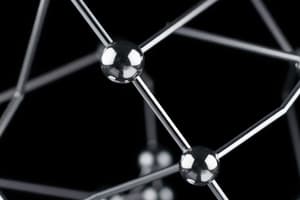Podcast
Questions and Answers
What does bonding theory predict?
What does bonding theory predict?
The shapes of molecules
What do the properties of molecular substances depend on?
What do the properties of molecular substances depend on?
The structure of the molecule
What are molecules considered to be?
What are molecules considered to be?
3 dimensional objects
What are the characteristic angles of geometric figures called?
What are the characteristic angles of geometric figures called?
What does Lewis theory predict?
What does Lewis theory predict?
What principle does VSEPR Theory explain?
What principle does VSEPR Theory explain?
Why should electrons be separated as much as possible?
Why should electrons be separated as much as possible?
What does a Lewis structure predict?
What does a Lewis structure predict?
What does each lone pair of electrons constitute?
What does each lone pair of electrons constitute?
What does each bond constitute?
What does each bond constitute?
How many basic arrangements of electron groups are there around a central atom?
How many basic arrangements of electron groups are there around a central atom?
What is the bond angle for linear geometry?
What is the bond angle for linear geometry?
What is the bond angle for trigonal planar electron geometry?
What is the bond angle for trigonal planar electron geometry?
What is the bond angle for tetrahedral electron geometry?
What is the bond angle for tetrahedral electron geometry?
What is the geometry for five electron groups?
What is the geometry for five electron groups?
What are the positions above and below the central atom in a trigonal bipyramidal arrangement called?
What are the positions above and below the central atom in a trigonal bipyramidal arrangement called?
What are the positions in the same base plane as the central atom in a trigonal bipyramidal arrangement called?
What are the positions in the same base plane as the central atom in a trigonal bipyramidal arrangement called?
What is the bond angle between axial and equatorial positions?
What is the bond angle between axial and equatorial positions?
What is the geometry associated with six electron groups?
What is the geometry associated with six electron groups?
How does molecular geometry differ from electron geometry?
How does molecular geometry differ from electron geometry?
What affects bond angles in a molecular structure?
What affects bond angles in a molecular structure?
What do lone pair groups do to electron groups?
What do lone pair groups do to electron groups?
What is the resulting shape when four electron groups around the central atom have one lone pair?
What is the resulting shape when four electron groups around the central atom have one lone pair?
How does the presence of two lone pairs affect four electron groups around the central atom?
How does the presence of two lone pairs affect four electron groups around the central atom?
What type of shape results when there are three electron groups and one lone pair?
What type of shape results when there are three electron groups and one lone pair?
What is the outcome when there are five electron groups and one lone pair?
What is the outcome when there are five electron groups and one lone pair?
What is a result of five electron groups with two lone pairs?
What is a result of five electron groups with two lone pairs?
What is the result of five electron groups with three lone pairs?
What is the result of five electron groups with three lone pairs?
The bond angles between equatorial positions are less than what value?
The bond angles between equatorial positions are less than what value?
What is the bond angle between axial and equatorial positions less than?
What is the bond angle between axial and equatorial positions less than?
What shape results from six electron groups with one lone pair?
What shape results from six electron groups with one lone pair?
What shape results from six electron groups with two lone pairs?
What shape results from six electron groups with two lone pairs?
What is the first step in predicting the shapes around central atoms?
What is the first step in predicting the shapes around central atoms?
What affects polar molecules?
What affects polar molecules?
How are polar molecules attracted?
How are polar molecules attracted?
Who is associated with Valence Bond Theory?
Who is associated with Valence Bond Theory?
What do molecular orbitals represent?
What do molecular orbitals represent?
In terms of stability, how do molecular orbitals compare to atomic orbitals?
In terms of stability, how do molecular orbitals compare to atomic orbitals?
What does hybridization entail?
What does hybridization entail?
What type of bond results when atomic orbitals point along the axis connecting two bonding nuclei?
What type of bond results when atomic orbitals point along the axis connecting two bonding nuclei?
What type of bond results when bonding atomic orbitals are parallel to each other?
What type of bond results when bonding atomic orbitals are parallel to each other?
What type of hybridization yields the lowest overall energy for a molecule?
What type of hybridization yields the lowest overall energy for a molecule?
Flashcards are hidden until you start studying
Study Notes
Bonding Theory and Molecular Shapes
- Bonding theory predicts the shapes of molecules, influencing their properties.
- Molecules exist as three-dimensional structures with specific bond angles.
- Lewis theory helps in predicting molecular shapes based on electron groups around central atoms.
VSEPR Theory
- Valence Shell Electron Pair Repulsion (VSEPR) theory states that electron groups are most stable when maximally separated, minimizing repulsions.
- Electrons repel each other due to negative charges; optimal separation results in predictable shapes and bond angles.
Electron Group Geometry
- Five basic arrangements of electron groups yield distinct geometries: linear, trigonal planar, tetrahedral, trigonal bipyramidal, and octahedral.
- Lone pairs occupy more space than bonding pairs, affecting molecular geometry and bond angles.
Molecular Geometry Types
- Linear Geometry for two electron groups leads to a bond angle of 180°.
- Trigonal Planar with three electron groups has a bond angle of 120°.
- Tetrahedral Geometry with four electron groups has a bond angle of 109.5°.
- Trigonal Bipyramidal with five groups includes axial (90°) and equatorial (120°) positions.
- Octahedral Geometry for six groups results in bond angles of 90°.
Effects of Lone Pairs
- Lone pairs influence molecular shape by occupying more space and affecting bond angles.
- Molecular geometries can diverge from ideal shapes due to lone pairs, leading to shapes such as pyramidal, bent, or T-shaped.
Specific Geometric Shapes
- Derivatives of trigonal bipyramidal geometry include seesaw (one lone pair), T-shaped (two lone pairs), and linear (three lone pairs).
- Derivatives of octahedral geometry include square pyramidal (one lone pair) and square planar (two lone pairs).
Hybridization and Bonding
- Hybridization involves combining orbitals to maximize bonding potential, producing hybrid orbitals.
- Orbital interactions create molecular orbitals, with stability resulting from paired electrons.
- Sigma (σ) bonds form through head-on overlap; pi (π) bonds form via parallel approach.
Bonding and Stability
- σ bonds are stronger than π bonds, allowing for free rotation without breaking the bond.
- Hybrid or nonhybrid hybrid orbitals interact to form σ bonds; π bonds require breaking orbital interactions for rotation.
Multiple Central Atoms
- Complex molecules can have multiple central atoms, requiring sequential shape descriptions for each atom based on their electron group arrangements.
Polarity of Molecules
- To be polar, a molecule must contain polar bonds, exhibit electronegativity differences, and have an asymmetrical shape.
- Polar molecules attract other polar molecules, affecting solubility properties, such as in water.
Summary of Bonding Concepts
- Valence Bond Theory blends quantum mechanics with chemistry, focusing on hybridization and molecular geometry.
- sp, sp², and sp³ hybridizations define molecular shapes corresponding to different numbers of electron groups.
- Use drawings reflecting three-dimensional shapes and bonds to convey molecular structures effectively.
Studying That Suits You
Use AI to generate personalized quizzes and flashcards to suit your learning preferences.




